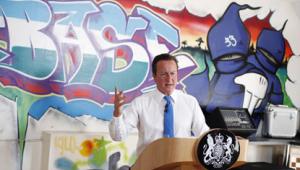In Prime Minister's Questions last week Gordon Brown and David Cameron clashed over the government's plans for spending on investment in public services. Cameron highlighted the fact that the government plans to cut investment spending. Brown responded that the government had deliberately brought forward investment spending and that investment spending had in recent years been higher than under the previous Conservative Government. So how do the plans for investment spending going forwards compare to Labour's record to date and to that of previous Conservative Governments?
The figure below shows how much investment (as a share of national income) has taken place each year since 1978/79 and what the latest Budget plans imply for spending through to 2017/18. After Labour came to power in 1997 the Treasury stated that ‘public investment has fallen to low levels by historical and international standards, even allowing for factors such as the effects of privatisation, and there are maintenance backlogs’. Despite this, investment spending remained low throughout Labour's first term in office, with the four years from 1997/98 to 2000/01 being the lowest four-year period of investment spending since the Second World War.
Since then investment spending has increased dramatically, reaching 2.1% of national income in 2007/08 (the last year before the financial crisis struck). The Comprehensive Spending Review (CSR) of October 2007 planned for investment spending to rise slightly before stabilising at 2.3% of national income, which if delivered would have been higher than the level delivered in any year since 1980.
But these plans have been dramatically changed in response to the financial crisis. The decision to bring forward some investment spending previously planned for 2010/11 into 2008/09 and 2009/10 to help ease the severity of the recession, and the fact that national income is currently depressed have led to a sharp increase in investment spending this year. In 2009/10 public sector net investment is now planned to be 0.9% of national income higher than planned in the last CSR, with a £10bn boost to investment spending plans (from £33.9bn to £43.8bn) explaining 70% of this increase and the lower level of national income explaining the remaining 30%. Both these factors will unwind, reducing investment spending as a share of national income. So Brown is correct in pointing out that some of the planned decline in investment spending between this year and next simply reflects the government's decision to bring spending forwards into the current year.
But, to help bring public sector net borrowing back down to sustainable levels, the government has also substantially revised down its longer-term plans for investment spending. Rather than having public sector net investment stabilise at 2.3% of national income a year it is now planned to be cut back to 1.3% of national income. So under these plans investment in public services each year will be at just under 60% of the level implied by the pre-financial crisis plans. This level of investment spending would be about the same as that delivered during John Major's premiership (1990/91 to 1996/97), a level deemed by Brown to be ‘chronic underinvestment’, which if continued would ‘leave the country run-down and ill-equipped for the future’.
Initially the impact of the reduced level of public sector investment from 2013/14 will be mitigated by the high levels of investment spending seen in recent years, although if Brown's criticisms of investment under Major are correct then maintenance backlogs would soon begin to re-emerge. Undoubtedly investing 1.3% of national income will deliver a lower quality and/or quantity of public services relative to a scenario in which 2.3% of national income was being invested each year. Which public services are affected - and to what extent - will not be known until the next Spending Review is announced. But areas that are relatively investment intensive - such as transport and housing, which make up 40% of all public sector investment - are set to be relative losers in a very tight spending settlement.
This post first appeared as an Institute for Fiscal Studies Observation
http://www.ifs.org.uk/publications/browse?type=tw











